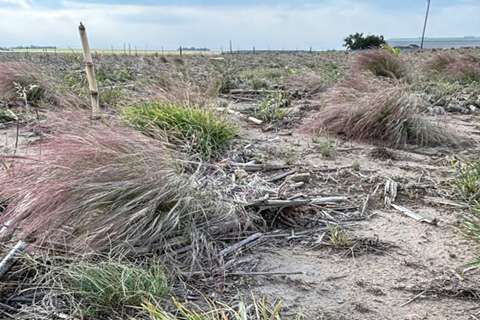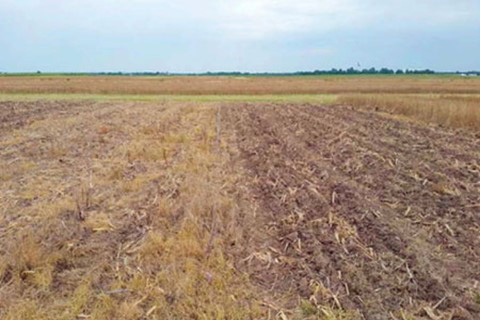The adoption of no-tillage (NT) farming increased water use efficiency and allowed for cropping intensification, especially in semi-arid environments like western Kansas, because of greater soil water storage with more crop residue kept on the soil surface. With more residue retained in NT systems, wind and water erosion are reduced, and more organic matter accumulates in the soil. However, despite these benefits, maintaining continuous NT has become increasingly challenging because of the lack of herbicide options for difficult-to-control and herbicide-resistant (HR) weeds, as well as issues with stratification of soil pH with increasing soil acidification near the surface.
The lack of effective herbicide options to control perennial grass weeds like tumble windmillgrass (Chloris verticillata Nutt.), tumblegrass (Schedonnardus paniculatus), and purple three-awn (Aristida purpurea Nutt.), as well as HR kochia (Kochia scoparia L.) and Palmer amaranth (Amaranthus palmeri S. Watson) pose some of the most significant challenges to long-term NT systems (Figure 1). With the increased costs of alternative herbicide options, increasing agricultural input costs, and reduced commodity prices, some farmers resort to tillage as a cost-effective strategy to manage weeds.

Figure 1. Purple three-awn, tumble grass, and tumble windmillgrass growing in a fallow field in Finney County. Note the nodding purple to red seed heads. Photo by Logan Simon, K-State Research & Extension.
K-State agronomists at the Western Kansas Research-Extension Centers in Hays, Garden City, and Tribune have studied strategic and occasional tillage in NT fields to manage difficult-to-control and HR weeds and evaluated impacts on crop yields and soil properties.
What is strategic tillage?
Strategic tillage is defined as a one-time tillage operation in an otherwise NT cropping system to manage challenges of long-term NT (Figure 2), including difficult-to-control weeds and pH stratification. Following this strategic tillage operation, the system returns to NT. The sweep plow, a non-inversion conservation tillage implement, is the most commonly used implement for strategic tillage. Inversion-type tillage with a disk may be preferable in correcting pH stratification if needed.

Figure 2. No-till (left) and strategic tillage (right) following tillage and fertilizer applications in fallow in Ellis County. Photo by Augustine Obour, K-State Research & Extension.
What is occasional tillage?
Occasional tillage is defined as one or two tillage operations every three or more years to manage challenges of long-term NT, including difficult-to-control weeds as well as soil nutrient and pH stratification. This system of low-frequency tillage on a fixed schedule differs from strategic tillage, which is defined as a one-time tillage operation in an otherwise NT cropping system. By these definitions, occasional tillage may be considered a proactive approach while strategic tillage may be considered more reactive. The most commonly used implement for occasional tillage is the sweep plow, which is a non-inversion conservation tillage implement. Inversion-type tillage with a disk may be preferable in correcting soil nutrient and pH stratification.
Research overview
Overall, strategic and occasional tillage of long-term NT had no adverse effect on soil properties. Tillage effects on subsequent wheat yields were infrequent, but results at Garden City suggested that yields might be greater with one pass of tillage in fallow before wheat planting compared to NT. However, grain sorghum yields were occasionally reduced with one or two passes of tillage in wheat stubble at Hays and Tribune. Occasional tillage could be an effective tool for farmers to manage difficult-to-control and HR weeds. For more information on the results of these studies, please refer to the 2024 Agronomy eUpdate articles, “Strategic tillage in long-term no-tillage systems” and “Occasional tillage strategies in dryland cropping systems”.
Best management practices when implementing strategic or occasional tillage
- Strategic or occasional tillage with a sweep plow should be timed when soil erosion risk is lowest. In western Kansas, the best time is in the summer fallow period ahead of winter wheat.
- Timing is critical to ensure successful control of perennial grass weeds. Tillage should be implemented with a sweep plow equipped with pickers, operated at shallow depth, on a hot, dry day with no chances for rain for several days following tillage.
- The tillage depth should be kept shallow (1-2 inches) to control perennial grass weeds (most are shallow-rooted) and prevent the burying of crop residue. Deeper tillage may only spread and bury the weed rhizomes, increasing management challenges.
- The frequency of strategic or occasional tillage will depend on the time it takes for issues to resurge after returning to NT management, though it may be six years or more between operations. More frequent tillage may negatively impact soil properties and crop yields.
For more detailed information on this study, please refer to:
- “Assessing the Influence of Strategic Tillage on Crop Yields and Soil Properties in Dryland No-Tillage Systems” in the 2023 Kansas Agricultural Experiment Station Research Reports: Vol. 9: Iss. 64. https://doi.org/10.4148/2378-5977.8487
- “Occasional Tillage in a Wheat-Sorghum-Fallow Rotation” in the 2025 Kansas Agricultural Experiment Station Research Reports: Vol. 11: Iss. 4. https://newprairiepress.org/kaesrr/vol11/iss4/9/
Logan Simon, Southwest Area Agronomist, Garden City
lsimon@ksu.edu
Augustine Obour, Soil Scientist, Hays
abour@ksu.edu
John Holman, Cropping Systems Agronomist, Garden City
jholman@ksu.edu
Lucas Haag, Agronomist-in-Charge, Tribune
lhaag@ksu.edu
Tags: no-tillage strategic tillage dryland occasional tillage